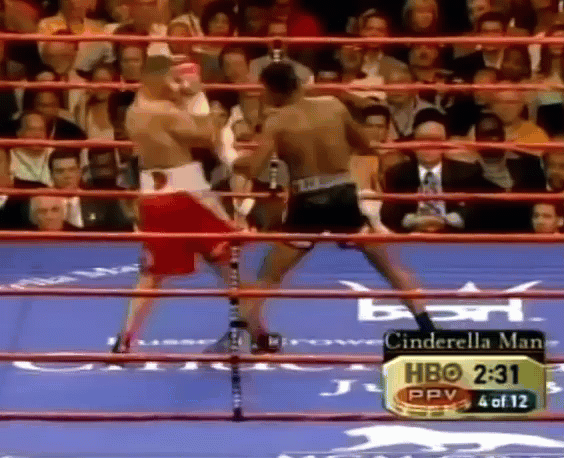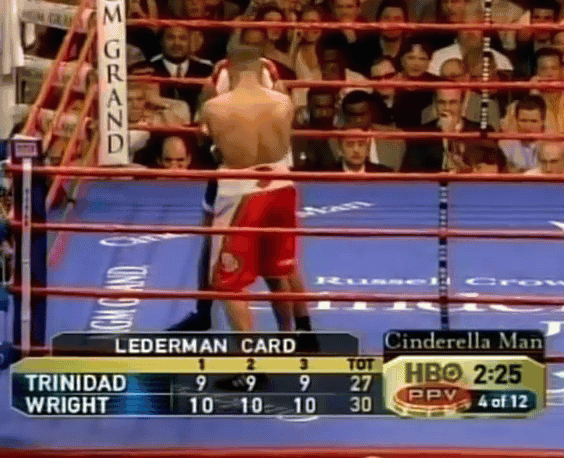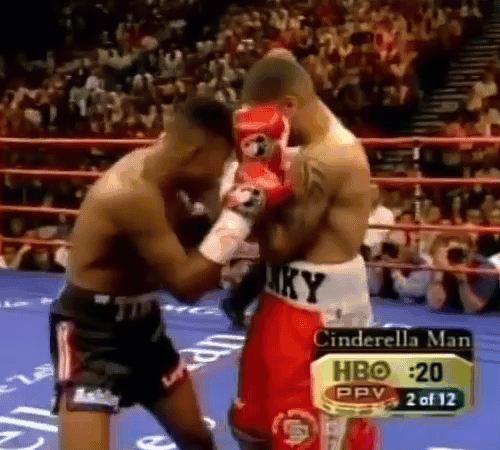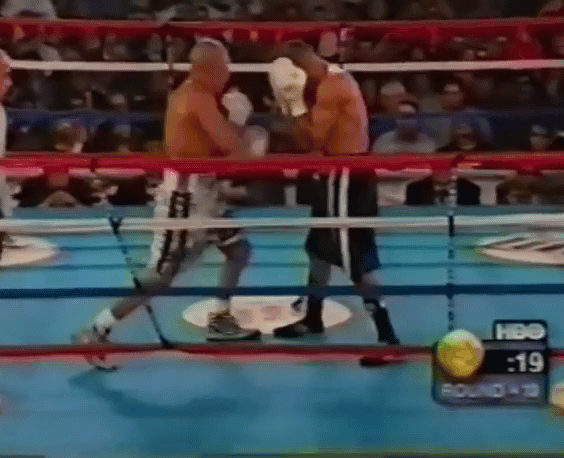Learning how to block punches early in your boxing, muay thai, or MMA training is critical. Having a reliable and energy-efficient guard to fall back on makes sparring a lot less stressful for beginners, which speeds up the entire learning process. It’s generally understood that the sooner you develop your guard and learn how to block punches, the faster you’ll gain the confidence you need to perform in sparring, competition, and self-defense situations.
Today’s post is not a blow-by-blow guide to blocking specific boxing punches, but rather a broader discussion of blocking concepts that apply to all combative sports and martial arts. If you’re a visual learner, you’re in luck, as we use film study principles to highlight specific blocking techniques from one of boxing’s best defensive fighters, Winky Wright (51-6-1).
By the end of this article, you’ll understand how professional boxers use an active guard to:
- Take force off of punches
- Safely pre-load counter punches
- Frustrate, threaten, and confuse the opponent
- Control the pace of the fight
Without further ado, we bring you 4 boxing do’s and don’ts for better blocking.
1. Keep your eyes on the opponent.
Closing the guard in front of the face is a common beginner mistake. Taking cover in this way feels safe, since your forearms and gloves literally block out the opponent, but it’s a dangerous defensive habit. In the words of light heavyweight legend Willie Pastrano, “it’s the punch you don’t see coming that knocks you out.”
While blocking, the elbows, forearms, and pinky sides of the glove may press together to form defensive “walls,” but they should never obstruct your vision. Blind spots slow your counter punches and leave you open to being caught unawares.
Make sure your “defensive wall” has embrasures built-in so you never lose sight of your opponent. These peepholes will look different depending on your chosen guard, but they’re central to all blocking styles.

Floyd Mayweather likes to carry his lead hand low and peer out from between his front shoulder and raised rear glove, whereas Winky Wright uses a more conventional “binocular” hand position from the high guard, but the embrasure is always there.
Once you know to leave a line of sight, the hardest part will be getting comfortable staring down your attacker. Finding the right hand positions doesn’t take long, but staying calm under fire must be earned through experience. Do your best, stay patient, and trust that the beginner’s instinct to flinch and turn away will be trained out of you over time. When I first started sparring, I found it helpful to focus on my breathing and watch for openings while I was under fire. Even if I wasn’t going to counter, looking for openings distracted me from the stress of being attacked, and kept me thinking instead of falling into fight-or-flight mode.
2. Keep your guard moving under fire.
Another key to good blocking is to accept that no single guard covers all openings. Some guards protect certain punching lanes better than others, but none are impenetrable. If there were a perfect guard, there would be no knockouts.
That may all seem perfectly obvious, but why then do so many beginners throw up a single, static hand position and expect it to work?
Keeping a static guard makes it very easy for opponents to find openings (or create them). It’s also a lot more tiring, as you have to resist the force of their punch to maintain your rigid hand position.
Instead, focus on keeping your guard moving under fire. Stay active using small movements to take force off shots and nudge punches off their course. Look for parries, brush body shots away with your elbows, and try to roll with your blocks.
From your opponent’s perspective, an active guard is much harder to deal with. By giving and taking different openings, you force them to aim at moving targets, while also threatening counter-offense with every turn of the gloves and shoulders.

Wright defends Felix Trinidad’s combination using an active guard.
While using an active guard, it’s important to keep your movements small. Smart opponents will pick up on excessive defensive movement right away, then start prying you open with feints. Parry attempts should move the hand no more than 3-4″ from the face, and upper body rotations should be subtle. When in doubt, remember that less is more; small movements cost less energy, give smaller openings, and keep you on-balance to transition to whatever technique is needed next.

Wright dips to meet Trinidad’s hook with the elbow, then lifts the hand to catch the hook upstairs. Small movements from an active guard kept him safe.
3. Vary your guards between exchanges.
In most cases, your guard should stay moving even when you’re not being attacked, for many of the same reasons we keep active under fire. This is what A Million Styles Boxing maestro Barry Robinson refers to as “giving a guy different looks,” and it falls in line with the “cloak and dagger fighting” concepts we discussed last week.Varying guards in the lulls between exchanges allows us to threaten with feints and camouflage attack movements, while simultaneously scrambling the opponent’s offensive radar. The combined effect of these threats and moving targets is that your opponent’s offensive output drops – they realize they need more time to figure you out, so they take it, which gives you a chance to breathe, or set up offense of your own.Use your gym time to experiment with as many different hand positions as you can. Try playing peek-a-boo, flow with the shoulder roll, get old-school with the cross-armed shell, and creep into your opponent’s comfort zone with a long, arms-out guard. Study film, identify hand positions to play with, and focus on smoothly transitioning from one to another. You’ll be surprised the effects these small in-between movements have on your opponent’s aggression.

Wright transitions from inside to outside behind the long guard.
4. Know how to block punches and slip in combination.
Beginners like to think of blocking and slipping as two distinct defensive techniques, but they really work best in combination. This refers to both 1) slipping and blocking simultaneously and 2) weaving slips and blocks into a longer defensive sequence. For the purpose of this article, we’re focusing on the latter.
Fighting somebody who blocks all of the time is great – it feels a lot like hitting a heavy bag. Even when you’re not landing flush, it’s reassuring to consistently be able to make contact with the opponent. Moreover, it makes it very easy to set up power shots, especially if you’re trapping and other hand-fighting techniques that involve manipulating the opponent’s gloves.
Don’t be the guy everyone loves to fight! Instead, you want to be the biggest pain you can be, combining slips with blocks to frustrate and tire your opponent. Whiffing a punch you thought you’d land takes a lot out of you, and that’s exactly the experience you want to give the person you’re fighting. Get them used to making contact on your gloves, then make them miss with a quick slip, pull, or weave once you’ve got a feel for their combination timing. More often than not, they’ll lose confidence and their punch output will plummet.

Wright shows how to block punches and slip in the same sequence. First, he allows his opponent to make contact with his guard, creating a false sense of security, then he makes him miss twice with a slick outside slip and pull.
Wrapping Up
While slips, parries, and footwork are generally preferred forms of defense because they stop you from absorbing any impact, basic blocking can take you a long way. On behalf of the Warrior Punch team, I hope these blocking tips keep you safe. Be sure to review our basic guide to boxing defense for more on blocking, or follow us on Facebook for exclusive fight tips.
As per usual, I leave you with a little inspiration:

Hi There,
Thank you for this great article.
I have a question.
When you are in a blocking position, you focus on your breathing, you watch your opponent, his moves.
How do you block, do you let his power come on your face with your gloves in front or do you try to block with your arms so your head is kind of not affected. So in other words, do you block with strong arms or do you let your upper body absorb it ? I am asking as it is not easy to block with the arms as there is a lot of power hitting them. I got the slipping at the same time, that’s great so the power gets deflected but still when you get some straight at you, how do you physically manage it ?
I am new at blocking, I prefer parrying or slipping a lot more but sometimes you don’t have a choice when you are under fire. ; )
Thanks a million.
Vincent
Great question Vincent!
As is often the case, you’ll find there is no “right” answer, but rather pros and cons to each style of blocking.
When blocking with the arms, you want to keep the guard moving. You don’t want to give them a sturdy “wall” to punch straight at, or you’ll take the full impact regardless of whether the punch lands. Instead, you want to roll the punch off with your block. The best way to do that is to keep the guard strong and turn the upper body/shoulders to create better ‘impact angles.’ The Winky Wright clip in point #2 illustrates this: Wright’s block moves to roll the steam off of Trinidad’s punches, but the guard movement involves his entire torso rather than just isolated arm movements. You mentioned slipping with the shot to deflect the power, and the same principle is in play here, only ‘smaller’ – rather than a full, committed slip, you’re making subtle tilts and turns with the guard up to take the heat off of punches.
Absorbing the power of a shot comes down to balance and a strong foundation. If you’re getting knocked around trying to block a guy’s punch, you might be standing too tall. Check this video out to see Floyd Mayweather correct one of his fighters making this mistake: https://www.facebook.com/WarriorPunch/videos/829793347170484/ Try to “sit down” into your stance when the punches start flying at you; it’s sometimes helpful to think of the body position you take to throw body punches – sitting down, widening stance slightly, even weight distribution. This will give you the shocks you need to absorb the impact. This might be a point worth adding to our article.
Thank you for this Jamie, so much to try on my next Sparring session. : )
Keep up the great work.